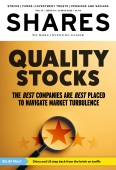Archived article
Please note that tax, investment, pension and ISA rules can change and the information and any views contained in this article may now be inaccurate.
Chip stocks can show if the economy (and stock markets) are cracked (or not)

Trade deals, talks with China and even the reversal of the Biden administration’s restrictions on exports of advanced silicon chips all help justify the furious rally in global share prices from the early-April lows, which means most, if not all, of the losses in major headline indices are now recouped.
The Trump presidency, thus far at least, therefore seems to be sticking to treasury secretary Scott Bessent’s script of ‘escalate to de-escalate,’ to raise hopes that the 90-day pause will see reciprocal tariffs rolled back.
Whether that leaves untouched the base, 10% tariff on imported goods into America remains to be seen. If so, the world will still be a less straightforward place than it was on 1 April, before Liberation Day, but the hit to global trade flows, corporate profit margins and consumers’ spending power may not be as bad as initially feared, if Trump and Bessent strike trade deals.
The move to replace the tiered structure for American semiconductor exports is particularly telling, given how technology, and access to its development in areas such as artificial intelligence, is still a flashpoint between Washington and Beijing. It adds to the tariff exemption for smartphones and computer hardware and potentially helps Nvidia (NVDA:NASDAQ) recoup some of the $5.5 billion in revenue it estimates it could lose if the Biden restrictions remain in place. It may also help boost the semiconductor industry more widely and thus reaffirm the importance of following its fortunes and those of the Philadelphia Semiconductor index, or SOX.
CHIPS WITH EVERYTHING
The SOX comprises 30 global makers and designers of both silicon chips and semiconductor production equipment, and it is worth following from an investment perspective for two reasons.
First, by dint of their ubiquity, silicon chips offer a good insight to global economic activity. Global sales have risen by around 8% on a compound annual basis over the last forty-odd years, but with some big booms and busts along the way. Worldwide sales are expected to grow by 11% and reach nearly $700 billion in 2025 and semiconductors are everywhere, from tablets to laptops, cars to robots, smartphones to servers and smart meters to medical equipment.
Second, the SOX has a decent history as a proxy for global risk appetite in financial markets. Chip and chip-making equipment firms are generally traded as momentum stocks, surging as earnings estimates rise and recoiling if they fall, thanks to how operationally geared they are: even a small percentage changes in sales leads to a much bigger percentage change in profits, thanks to the fixed costs associated with research and development and, in some cases, the hugely capital-intensive nature of the business (a state-of-the-art semiconductor fabrication facility, or fab, now costs billions of dollars).
Investors will note how the SOX peaked before the wider markets in 2000 and 2007 and bottomed in 2002 and 2008 before the headline indices started to turn for the better.
FEAST OR FAMINE
At this point, we must acknowledge that the past is no guarantee for the future, but the SOX made a good job of spotting 2022’s economic slowdown and subsequent stumble in the S&P 500.
That downturn in the SOX was the result of a marked deceleration in sales and a big drop in profits across the industry and specifically at its members.
The good news is that consensus analysts’ forecasts expect very strong profits growth in 2025, 2026 and 2027. The less good is that the SOX members’ aggregate market capitalisation of $6.2 trillion, three quarters of which comes from just Nvidia, Broadcom (AVGO:NASDAQ), TSMC (2330:TPE) and ASML (ASML:AMS), trades on 26 times, 21 times and 17 times those respective earnings forecasts, multiples which do not offer much downside protection of anything goes wrong, so those earnings (and a few upside surprises) had better come through.
Thankfully, there is a way to see if the forecasts are in with a chance of being realistic and that is to check chip stocks’ cashflows and balance sheets. If growth in capital investment and growth in inventory starts to outstrip growth in sales across the SOX’s 30 members, then watch out, because there could be trouble ahead, as supply catches up with, and then exceeds, demand.
This is exactly what happened in 2022 and 2023, with the result that profits plunged and took the SOX with it. Capex cuts and inventory digestion (or write-downs) followed.
That hair-shirt episode now looks to be behind us, so investors need to keep an eye on cash flows and balance sheets and look beyond just the headline earnings per share numbers, to see if the SOX is going pull wider indices like the S&P 500 up or down with it.
Important information:
These articles are provided by Shares magazine which is published by AJ Bell Media, a part of AJ Bell. Shares is not written by AJ Bell.
Shares is provided for your general information and use and is not a personal recommendation to invest. It is not intended to be relied upon by you in making or not making any investment decisions. The investments referred to in these articles will not be suitable for all investors. If in doubt please seek appropriate independent financial advice.
Investors acting on the information in these articles do so at their own risk and AJ Bell Media and its staff do not accept liability for losses suffered by investors as a result of their investment decisions.
Issue contents
Education
Exchange-Traded Funds
Feature
Great Ideas
News
- Why shares in sofa seller DFS Furniture are springing back
- Raft of bad news sends Mobico shares 62% lower year-to-date
- UK consumer confidence falls as unemployment begins to rise
- Markets enjoy relief rally as China and US step back from brink of all-out trade war
- Pharma stocks face volatility on US plan to reduce drug prices
 magazine
magazine








